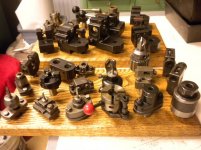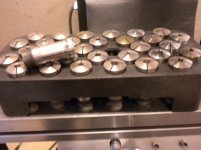mastuart
Aluminum
- Joined
- Feb 25, 2013
- Location
- Mendota Il USA
Shop is a mess with tooling lying around everywhere. I just got a couple of Lista cabinets and Im trying to get organized. Anyhow I have a lot of tooling for my Harding DSM 59 that have 5/8 shanks. I have some 1 inch thick oak boards that I bored a series of holes for the tooling shanks. Will I have any problems with rust on the shanks with using the oak wood. The reason I ask is because in the past I bought a cheap set of brazed carbide boring bars that came in a wooden stand. They sat in a cabinet for a long time and when I went to use them the shanks were very rusty. I don't know what kind of wood it was but nothing else in the cabinet got rusty. I don't think I have a big moisture problem because most things don't get rusty. If the oak will work alright should I put some kind of finish on the wood like some Watco Danish oil. Should I wipe the shanks down with some kind of oil before I put them away after use?
Mark
Mark






